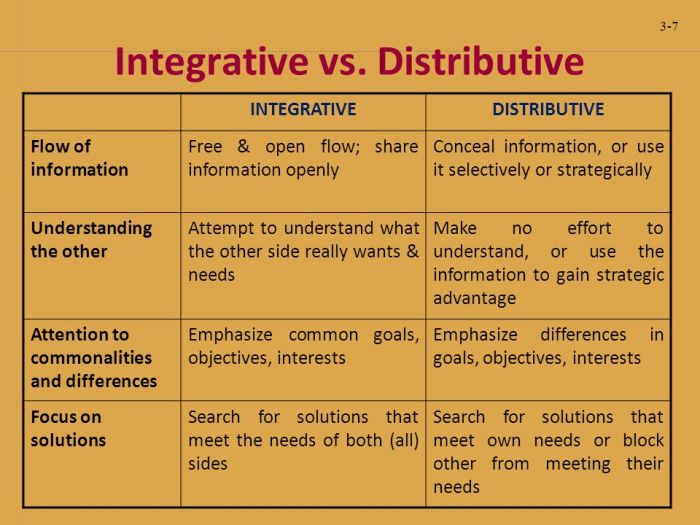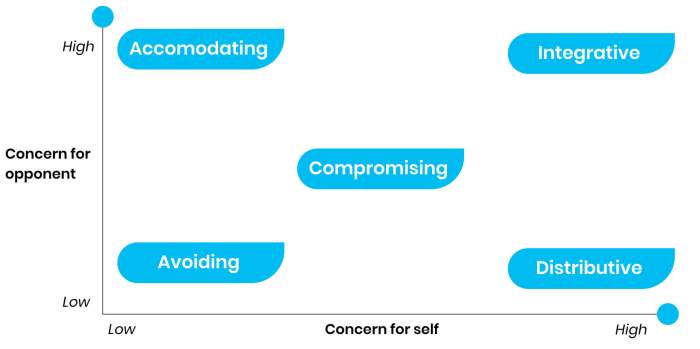Using distributive tactics in a fundamentally integrative situation – Using distributive tactics in fundamentally integrative situations presents a paradoxical scenario that warrants careful examination. Distributive tactics, often employed in competitive environments, aim to maximize individual gains at the expense of others. Conversely, integrative situations prioritize collaboration and mutual benefit, seeking to create value for all parties involved.
This article delves into the complexities of employing distributive tactics within integrative settings, exploring their potential consequences, benefits, and drawbacks, and offering alternative approaches for effective conflict resolution.
As we navigate the intricate dynamics of integrative situations, it becomes imperative to understand the fundamental differences between distributive and integrative approaches. Distributive tactics, rooted in a win-lose mentality, focus on dividing resources and claiming a larger share for oneself.
Integrative tactics, on the other hand, emphasize collaboration, open communication, and a shared commitment to finding mutually acceptable solutions that maximize collective gains.
1. Distributive Tactics and Integrative Situations
Distributive and integrative situations are fundamentally different types of negotiations. Distributive situations involve a fixed pie, where one party’s gain is another party’s loss. Integrative situations, on the other hand, involve a variable pie, where both parties can potentially benefit.
Examples of distributive situations include salary negotiations, where there is a limited amount of money available and one party’s increase in salary must come at the expense of the other party. Examples of integrative situations include joint ventures, where both parties can potentially benefit from working together.
Using distributive tactics in an integrative situation can have negative consequences. Distributive tactics can lead to a focus on short-term gains at the expense of long-term relationships. They can also create a sense of distrust and make it difficult to reach a mutually beneficial agreement.
2. Common Distributive Tactics

Common distributive tactics include:
- Competitive bargaining:This involves trying to get the best possible deal for oneself, without regard for the other party’s interests.
- Bluffing:This involves making false statements or threats in order to gain an advantage.
- Stonewalling:This involves refusing to negotiate or provide information.
- Intimidation:This involves using threats or other forms of pressure to force the other party to accept one’s demands.
These tactics can be effective in achieving short-term gains, but they can also damage relationships and make it difficult to reach a mutually beneficial agreement.
3. Effects of Distributive Tactics on Integrative Situations
Distributive tactics can have a negative impact on integrative situations. They can:
- Hinder cooperation:Distributive tactics can create a sense of distrust and make it difficult for parties to work together.
- Limit creativity:Distributive tactics can lead to a focus on short-term gains at the expense of long-term benefits.
- Damage relationships:Distributive tactics can damage relationships between parties, making it difficult to work together in the future.
Examples of how distributive tactics have been used in real-world integrative situations include:
- In the Israeli-Palestinian conflict, both sides have used distributive tactics, such as competitive bargaining and stonewalling, which have hindered cooperation and made it difficult to reach a peace agreement.
- In the United States, the government has used distributive tactics, such as threats and intimidation, to force other countries to accept its demands.
4. Alternative Approaches to Integrative Situations

There are a number of alternative approaches to managing integrative situations, including:
- Collaborative negotiation:This involves working together to find a solution that meets the interests of both parties.
- Problem-solving:This involves identifying the underlying interests of both parties and working together to find a solution that meets those interests.
- Mediation:This involves using a neutral third party to help facilitate communication and negotiation.
These approaches are more likely to lead to mutually beneficial agreements and preserve relationships.
5. Strategies for Avoiding Distributive Tactics: Using Distributive Tactics In A Fundamentally Integrative Situation

There are a number of strategies that can be used to avoid the use of distributive tactics in integrative situations, including:
- Building trust:Trust is essential for successful integrative negotiations. Parties need to be able to trust each other to be honest, cooperative, and willing to work together.
- Communicating effectively:Effective communication is essential for understanding the interests of both parties and finding a mutually beneficial solution.
- Focusing on the long term:Distributive tactics can lead to short-term gains at the expense of long-term benefits. Parties need to focus on the long term and work together to find a solution that meets the interests of both parties.
6. Case Studies and Examples
Case studies and examples of real-world situations where distributive tactics have been used in integrative situations include:
- The Israeli-Palestinian conflict:Both sides have used distributive tactics, such as competitive bargaining and stonewalling, which have hindered cooperation and made it difficult to reach a peace agreement.
- The United States’ use of distributive tactics in international negotiations:The United States has used distributive tactics, such as threats and intimidation, to force other countries to accept its demands.
- The use of distributive tactics in business negotiations:Distributive tactics can be used in business negotiations to try to get the best possible deal for oneself, without regard for the other party’s interests.
These case studies and examples illustrate the negative consequences of using distributive tactics in integrative situations.
Frequently Asked Questions
What are the key differences between distributive and integrative tactics?
Distributive tactics prioritize individual gains at the expense of others, while integrative tactics focus on collaboration and mutual benefit.
What are the potential consequences of using distributive tactics in integrative situations?
Distributive tactics can undermine trust, hinder collaboration, and jeopardize long-term success.
What are some alternative approaches to managing integrative situations?
Alternative approaches include collaborative negotiation, interest-based bargaining, and principled negotiation.
What are some strategies for avoiding the use of distributive tactics in integrative situations?
Strategies include fostering open communication, building trust, and focusing on shared goals.